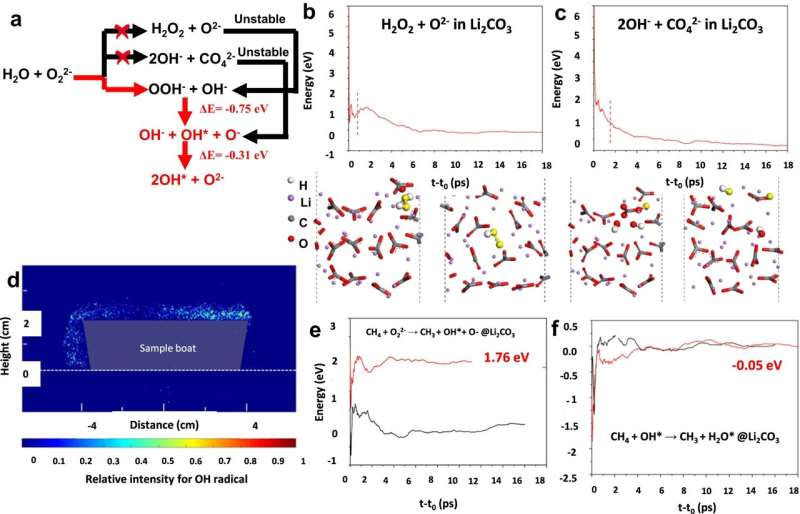This article has been reviewed according to Science X's editorial process and policies. Editors have highlighted the following attributes while ensuring the content's credibility:
fact-checked
peer-reviewed publication
trusted source
proofread
Core-shell 'chemical looping' boosts efficiency of greener approach to ethylene production

Ethylene is sometimes called the most important chemical in the petrochemical industry because it serves as the feedstock for a huge range of everyday products. It's used to produce antifreeze, vinyl, synthetic rubber, foam insulation, and plastics of all kinds.
Currently, ethylene is produced through an energy- and resource-intensive process called steam cracking, where extremes of temperature and pressure produce ethylene from crude oil in the presence of steam—and, in the process, emit tons of carbon dioxide into the atmosphere.
Another way in which ethylene can be produced, however, is through a process called oxidative coupling of methane (OCM). It has the potential to be a greener alternative to steam cracking, but until recently, the amount of ethylene it yields did not make the process economically viable.
"So far, the catalytic yield has been below 30% for a single pass, meaning just passing the methane and oxygen through the catalyst and getting ethylene on the other side," says Bar Mosevitzky Lis, a postdoctoral research associate in the Department of Chemical and Biomolecular Engineering in Lehigh University's P.C. Rossin College of Engineering and Applied Science.
"Studies that have simulated the entire industrial process using OCM have shown that the technology doesn't become profitable until the single pass yield reaches between 30 and 35%."
OCM is now one step closer to leaving the lab and entering the real world. For the first time, researchers at North Carolina State University (NCSU) and Lehigh University, in collaboration with researchers from the Guangzhou Institute of Energy Conversion and the East China University of Science and Technology, have developed an OCM catalyst that exceeds 30% when it comes to the production of ethylene.
The paper describing their breakthrough was recently published in Nature Communications.
The collaboration was led by Fanxing Li, Alcoa Professor of Engineering at NCSU. His team developed a class of core-shell Li2CO3-coated mixed rare earth oxides as catalysts for the oxidative coupling of methane using a chemical looping scheme. The result was a single-pass yield of up to 30.6%.
"The idea with chemical looping is that instead of doing a co-feed of methane and oxygen into the chamber with the catalyst, you do it sequentially," says Mosevitzky Lis, who is also one of the study's co-authors.
"Over time, you lose oxygen from the catalyst and it becomes ineffective. With chemical looping, you start with methane, then switch to oxygen, then back to methane, and the oxygen serves to continually reoxidize the catalyst, thereby replenishing its ability to provide oxygen for the reaction."
Mosevitzky Lis and his team at Lehigh—led by Israel Wachs, G. Whitney Snyder Professor of Chemical and Biomolecular Engineering and Director of the Operando Molecular Spectroscopy and Catalysis Research Lab—did the characterization of the catalyst.
"Our specialization is with in situ surface characterization," says Mosevitzky Lis, "meaning we characterize the surface of catalysts while the reaction is running. We apply a wide array of physical and chemical techniques to understand the transformations catalysts undergo while the catalytic reaction runs on their surface and how these transformations relate to what makes them such good catalysts."
He says the catalyst is composed of a mixed oxide core covered by lithium carbonate, and the interaction between the core and the shell during chemical looping is responsible for the high yield. The results mean that, for the first time, upgrading methane—which can be found in natural gas and biogas—into ethylene could be within reach for industry.
"OCM has the potential to be cheaper and more efficient when it comes to energy and emissions," he says. "Plus, instead of using crude oil, you're using methane that typically comes from natural gas but may also be generated in the future from biogas and the electrochemical reduction of carbon dioxide. And once you have ethylene, you're able to transform it into countless products that are used by the whole world."
The next step is to determine the suitability of the catalyst for industrial-scale production while trying to push the yield even further up. For now, however, having finally improved on a method that's remained an unfulfilled promise since the 1980s marks a milestone.
"The intricacy of the system and the dynamics that take place, it's almost like art," says Mosevitzky Lis. "Both the core and the shell of the catalyst undergo very extreme processes, generating all kinds of interesting things on the surface. It's beautiful."
More information: Kun Zhao et al, Lithium carbonate-promoted mixed rare earth oxides as a generalized strategy for oxidative coupling of methane with exceptional yields, Nature Communications (2023). DOI: 10.1038/s41467-023-43682-5
Journal information: Nature Communications
Provided by Lehigh University





















